WAYFARE is a next-gen travel agency with Voya, an AI agent, at its core. The project reimagines trip planning as a conversation instead of endless tabs, top-ten lists and search fatigue. Users answer a few personality-driven and logistical questions and Voya translates that into a personalised itinerary delivered to their inbox.
When you type something as vague as “I want something cinematic, adventurous, but still chill”, Voya gets to work behind the scenes. It identifies possible cities, narrows to those that fit your dates and budget, and suggests a trip that balances pace with aesthetics. The interaction itself becomes an anticipatory dialogue: one where media learns to infer what you might mean next.
In this report I trace the project from first pitch to working prototype, including what broke, what I fixed (hello, JSON), and how the framing evolved from “AI agent” to “anticipatory media.” You can explore the live build at gowayfare.xyz. What follows is a visual walkthrough of my process, the problems I solved and how my framing evolved.
Go travel. Go explore the world. Go WAYFARE.
Try out the prototype at gowayfare.xyz
A side note, over the long weekend, I booked a last-minute trip to Europe for right after Uni (literally the day after I finish classes), and so by the time this is being read, I’m probably somewhere overseas testing it for real! I’m meeting up with my mate Marcus (who I worked on Tapeify with!) and we’re backpacking through the UK, Germany, Switzerland and France. Planning the trip while working on WAYFARE turned out to be the ultimate tester. I’ve been using Voya to map out train routes, find hiking trails, and hidden local spots in the places we’re headed. The fact that it’s been genuinely useful to me has made this one of the most rewarding digital artefacts I’ve worked on.
Framing
The shift driving WAYFARE is that digital media is moving from reactive systems that respond to prompts, to anticipatory ones that predict needs before they are expressed. The term “anticipatory dialogue” defines this: conversations that generate action through interpretation. OpenAI’s update on ChatGPT Agents outlined a model where agents identify intent, execute tasks across tools, and loop responses into continuous learning cycles. Interfaces now act as collaborative environments where media predicts what matters next.
In one exchange with Voya, I wrote that I “might want to see the Swiss Alps.” The backend agent processed that cue, mapped routes through Switzerland, compared rail passes, and surfaced a note on scenic timing, “sunrise trains from Lauterbrunnen offer the best light for photography.” This showed how anticipatory systems make micro-decisions within dialogue, shifting media from passive response to active participation.

WAYFARE began from the idea of an AI agent designed to execute travel tasks efficiently and reduce friction in planning. Early prototypes revealed a deeper layer of interaction inside the conversation itself. The agent started interpreting tone, sentiment, and intent before explicit instruction. That moment reframed WAYFARE from a technical build into an exploration of anticipatory media.
Last month, OpenAI made a leap in the field with ChatGPT Pulse. Pulse is a proactive mode where ChatGPT conducts ongoing research and delivers personalised updates drawn from a user’s chats, feedback and connected apps such as calendars. Users can guide what’s relevant, while the system curates visual update cards that appear each day with new, focused insights.
"There's magic in being able to simply ask and get answers to help you learn, create or solve problems. However that's limited by what you know to ask for and always puts the burden on you for the next step.
Now ChatGPT can start the conversation. Rolling out on mobile."
OpenAI (Introducing ChatGPT Pulse)
Anticipatory dialogue expands the function of AI agents. These systems act within the process of sensemaking, creating shared understanding between human and machine. McLuhan’s statement that “the medium is the message” clarifies this evolution. As AI anticipates, the medium shapes meaning by constructing relationships between context and action. WAYFARE operates within that space, showing how anticipatory systems turn media into cognitive partners that influence attention, timing and perception.
This shift reshapes decision-making, autonomy and experience. As The Conversation noted, outsourcing sensemaking risks eroding our ability to choose for ourselves. Yet it also introduces efficiency within information-heavy environments where data volume slows human judgment. That balance defines WAYFARE's purpose: to examine what occurs when media begins to anticipate human needs. Entman’s work on framing helps here too because what the agent chooses to emphasise or hide in an itinerary is itself a frame, shaping how travellers see the trip options in front of them.
In travel, this anticipatory turn is already accelerating. According to Globetrender’s 2025 report on AI-enhanced travel, demand for generative trip planning is up 64% year-on-year, with most travellers willing to pay for it. But a quarter still report “outdated or impersonal” results, showing that anticipation without understanding context can miss the mark. WAYFARE addresses this through design logic that prioritises nuance and reasoning.
Building Voya under this frame established that the agent operates as a collaborator in sensemaking. It extends curiosity and assists judgment through reasoning that feels transparent. The aim became to build dialogue that feels intuitive enough to trust, yet open enough for human correction.
Framing WAYFARE as an experiment in anticipatory dialogue means situating it within a broader systemic change: AI as media instead of a more traditional middleware. It’s a shift in how discovery, trust and decision-making are mediated. Across culture, commerce and communication, systems are learning to think ahead of us. Designing WAYFARE became a small-scale test of how those patterns might play out, looking into how media that predicts, recommends and adjusts in real time can either deepen or dilute genuine experience.
That tension between anticipation and autonomy will define the next decade of digital design. And that’s exactly what WAYFARE was built to explore.
Project Development
WAYFARE began as an attempt to simplify how people plan travel. The goal was to create an AI agent that could collect context, understand intent, and generate personalised itineraries with minimal input.


The foundation came from an earlier university project, Tapeify, where my group used UChat to generate Spotify playlists based on user moods. My teammate James had documented his entire setup, which made me realise UChat could be used to guide structured conversations that result in usable data.
I began with the website. In past projects I’d worked in WordPress, Shopify, Wix, Squarespace and Webflow. Right now your interacting with my personal website that I built and coded using Webflow. I also used Webflow to build SoundCircle.




For the website, I wanted something that could hold visual impact without needing a complex backend. Readymag felt right for this one. It’s fast, flexible and suited to experimental builds. I saw it as a chance to create a minimal, editorial-style experience, designing something that feels cinematic but runs simply.
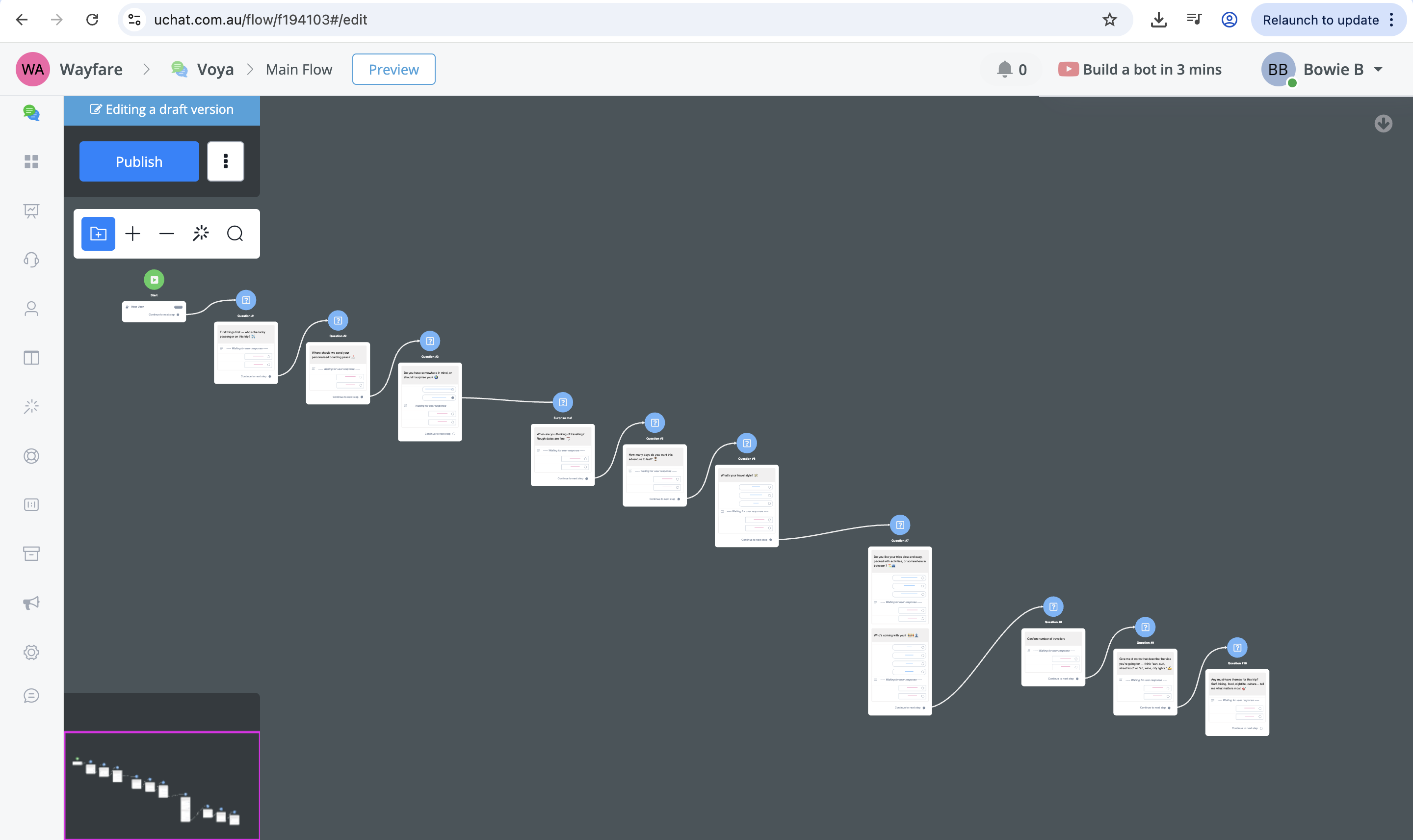
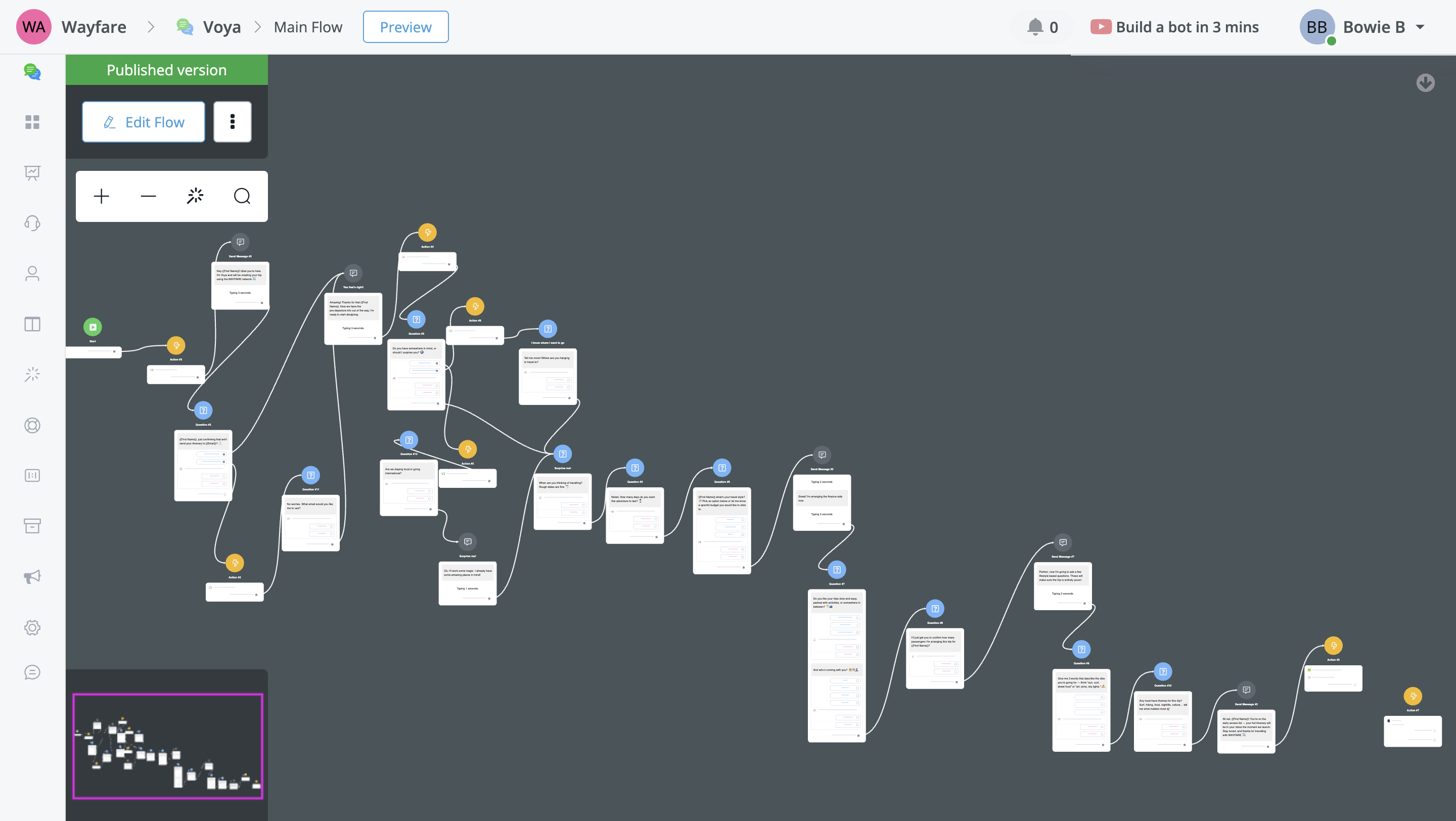

Once the base site was ready, I started developing the conversation flow for Voya in UChat. My first prototype handled destination, budget and travel dates, but I quickly hit UChat’s restriction of only three custom fields. Every new response overwrote the previous one. This forced me to think differently about data. For a while, it felt like the whole concept might stall. I pressed on knowing I would find a workaround eventually.



With the technical base forming, I set up gowayfare.xyz and a mailbox at trips(at)gowayfare(dot)xyz. This let me build and test a complete loop: collect user input, generate content, and send a result via email. That domain also laid the groundwork for deliverability tests later on.


Once the domain was live, I began experimenting with audience engagement. I launched an Instagram page for WAYFARE, posted three reels and three static posts, and reached 2.1k unique accounts, 85% of which were non-followers. The results confirmed that the aesthetic resonated and that organic discovery was possible. I followed this with an early-access landing page to collect user emails before rollout.
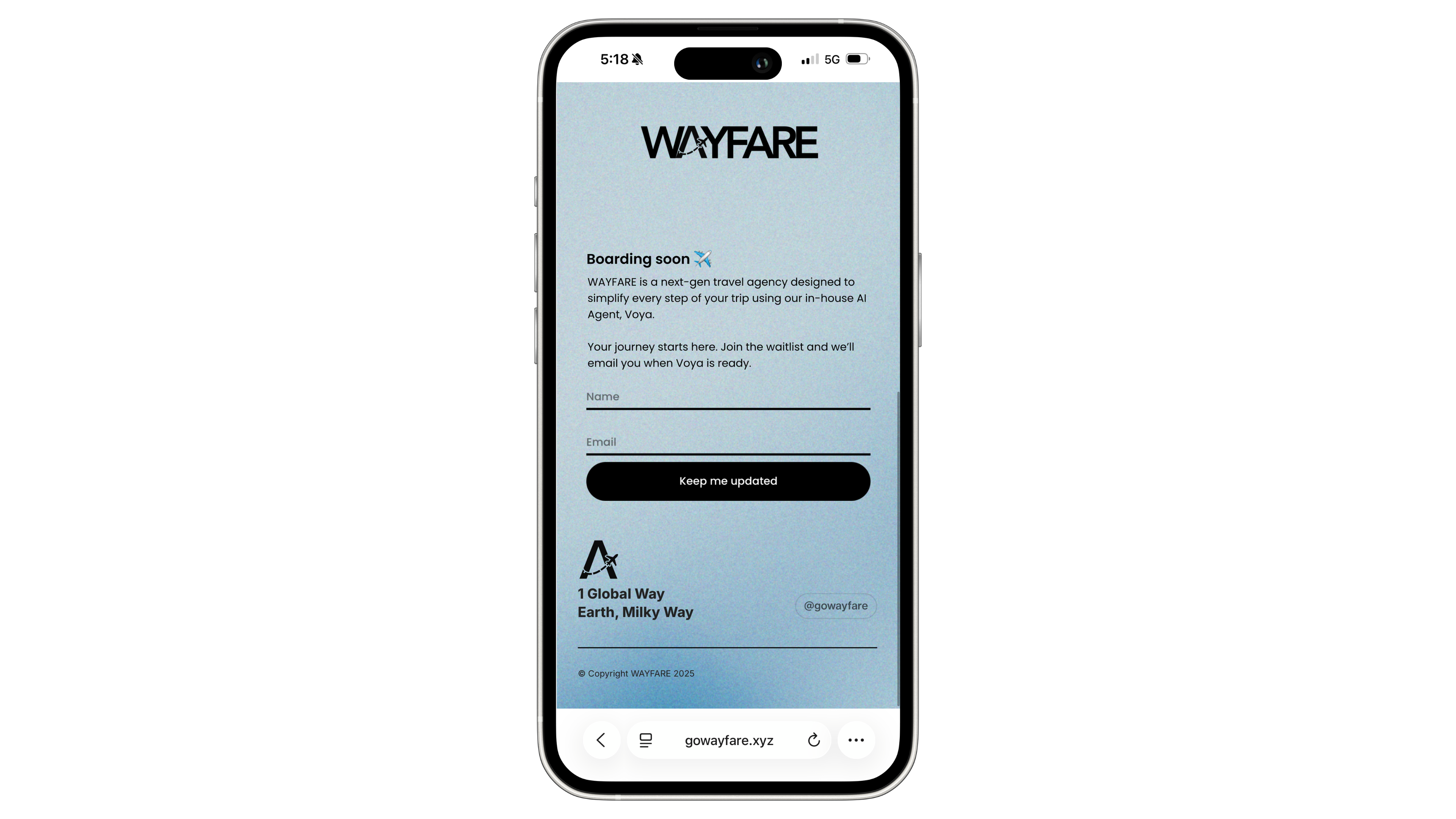

At the same time, I started iterating on what the itinerary should look like. Using Canva, I designed a PDF template that balanced clarity with tone. The structure needed to reflect pace and personality. If a user described a “slow, cultural trip,” the layout had to visually communicate calmness. The design process clarified what data points mattered most, shaping how I would later instruct the AI agent.


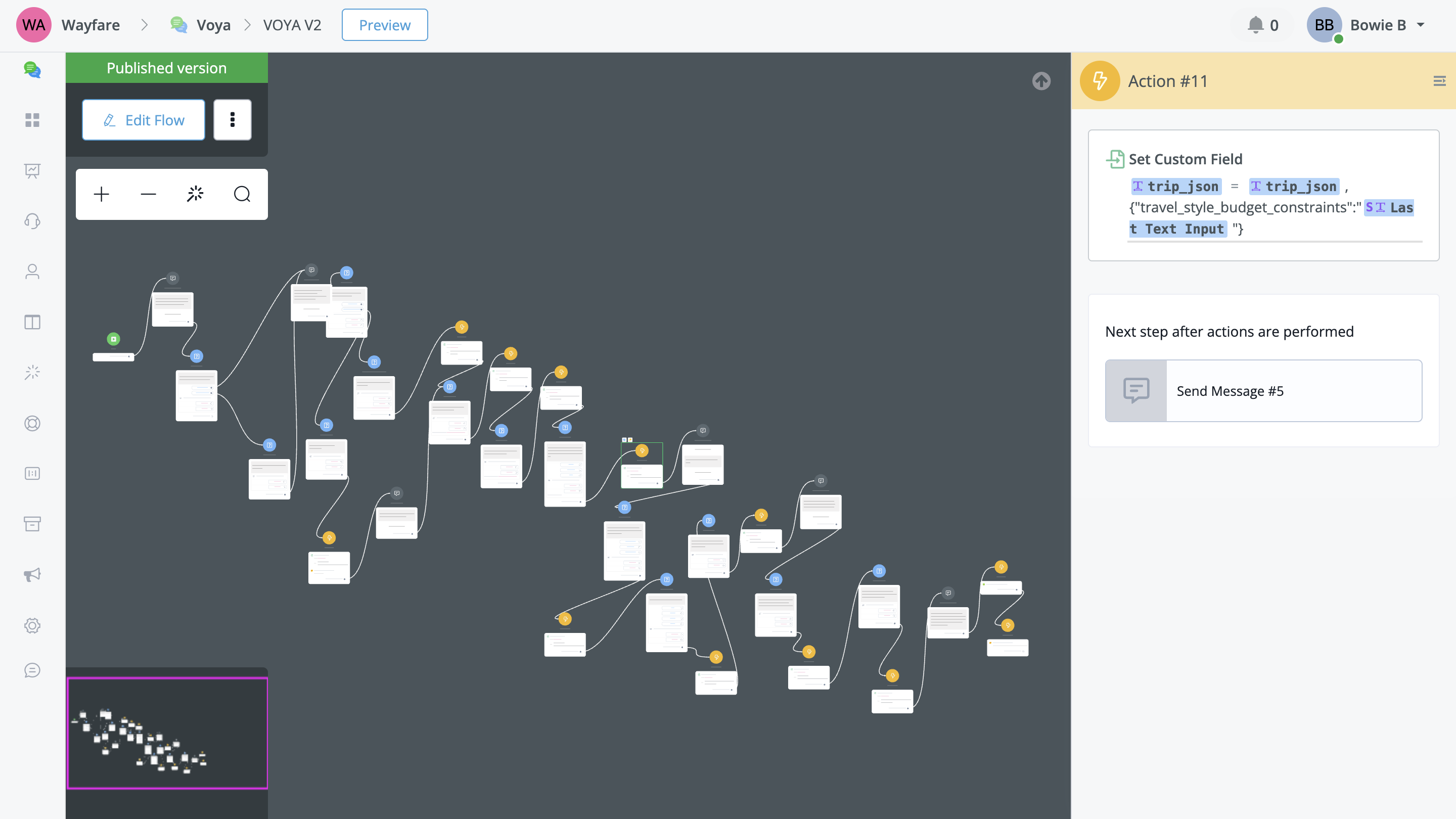
Only after the front end was complete did I revisit the data issue. I restructured the backend logic to bundle all user responses into a single JSON string instead of separate fields. This append method worked — each answer added context rather than replacing it.

Then the next major failure hit. My UChat trial expired, which disabled several key features, including the typing lock that kept users from interrupting mid-sequence. Without it, the bot stalled or repeated messages. I rebuilt each step to handle interruption by checking the last saved state and resuming from there. It took longer to run, but it bandaged the break.


The next challenge was finding the right AI integration. UChat's in-house AI Agent failed to work. I tested Intercom, but its agent system is built for customer support, not generation. I then tested Perplexity AI under its student plan, which could reason well but sometimes pulled unreliable sources. Depending on SEO rankings, it might reference low-quality or outdated sites. For something like travel planning, that’s a major issue. It’s essentially the AI equivalent of mixing up “to Nice” with “to Tunis.”

I created a custom GPT within ChatGPT’s builder next. It could read the JSON from UChat, interpret it correctly, and generate itineraries that felt coherent. This prototype worked better than expected. I could hand it data and get a structured itinerary in minutes. It still required manual input, but it showed how close the workflow was to full automation.
When it came to sourcing, I realised the model occasionally cited low-trust content. To prevent this, I created a whitelist of sources in the instructions, being official tourism sites, verified databases and established publications. This improved reliability.
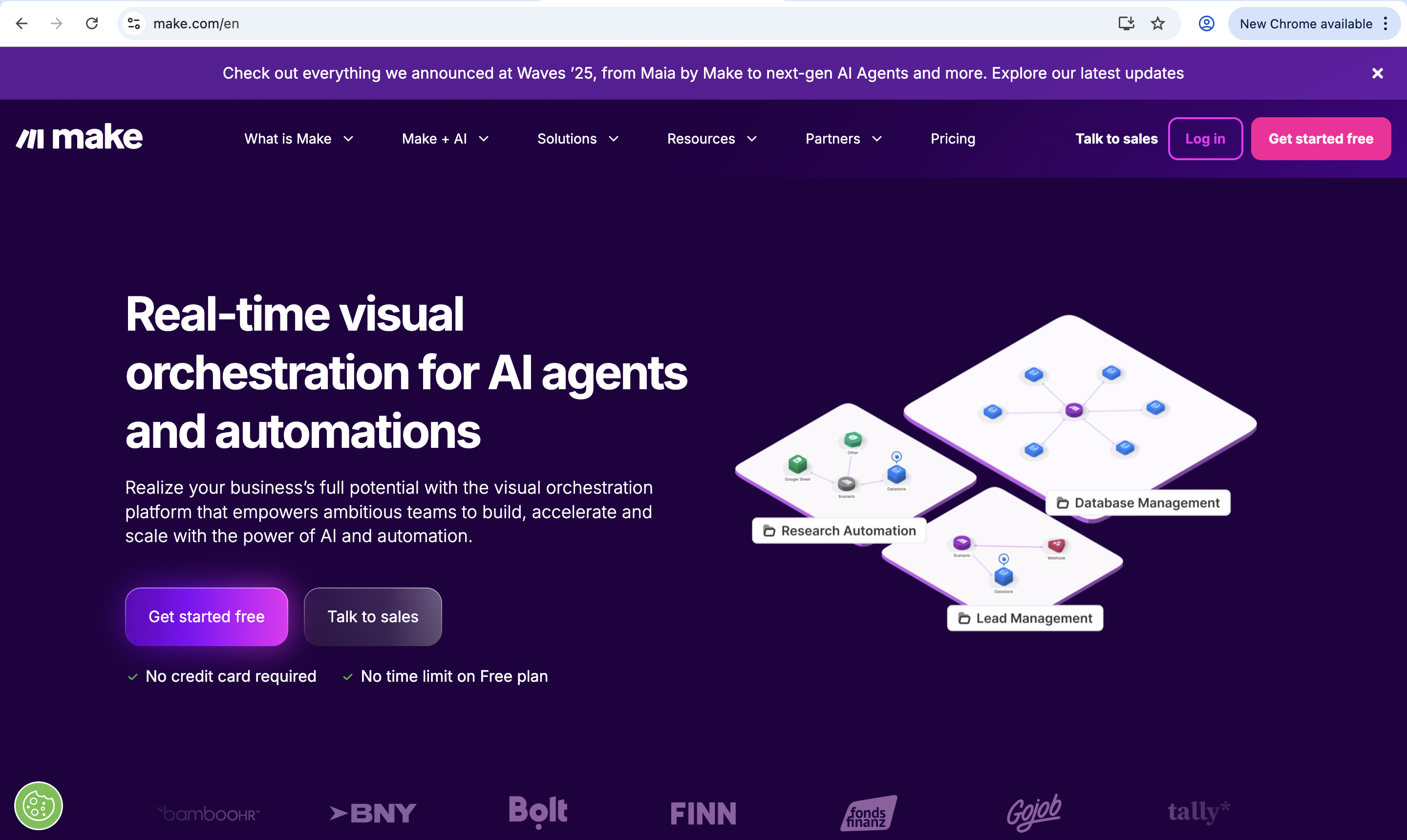

Despite multiple attempts, the system never reached full automation. Many platforms had steep paywalls that locked key features behind enterprise tiers. I moved the build to Make.com to connect everything, but each fix uncovered a new dependency (like figuring out how to embed the Make agent into the website) and every improvement introduced another failure point, such as token limits or broken API calls. After several weeks of trial and error, I realised the limitation was structural rather than creative or conceptual. Without a big budget or deep coding knowledge, the tools I was using could only run in isolation and struggled to stay connected under continuous load.
At this stage, WAYFARE operates as a partial system. The front end collects user inputs, my custom Voya GPT interprets and plans with strong accuracy, and I can feed that data into the Canva template before exporting it as a PDF and sending it from the gowayfare.xyz domain. The workflow is functional but still stitched together.
The agent within Voya behaves as intended. It anticipates needs, infers preferences, and generates responses that feel personal, but it operates inside a fragmented ecosystem. That tension has become the project’s most valuable outcome. It shows how anticipation can exist even when integration fails, and how AI sensemaking depends as much on connection as cognition.
WAYFARE sits at that intersection. It works well enough to prove the concept and fails clearly enough to reveal the next challenge: building anticipation that holds together across systems. Over the next decade, anticipatory media will define how people navigate information, automate judgement, and interact with decision systems. WAYFARE now demonstrates both the potential and the constraint of media that anticipates—and the reality of building experimental systems.
Key Takeaways
Building WAYFARE, I learned that designing AI systems isn’t just about capability but constraint: data limits, API stability and user experience all have to work together for trust to exist. Every technical failure like the JSON overwrites, expired trials, token limits and even my technical knowledge, taught me more about the real barriers to automation than the successes did.
Through this project, I also realised how important it is to design for context. The agent doesn’t need to do everything; it needs to do the right things well. Early feedback on tone, pacing and rationale proved that people trust automation more when it feels transparent and grounded in reasoning. Adding small human explanations made the AI feel more competent.
In a broader sense, WAYFARE reflects how digital systems are shifting from reactive to anticipatory which is a transition that will shape industries beyond travel. Building it forced me to think critically about what happens when media starts acting before we ask. The process made me more interested in the systemic implications: how much choice users actually want to give up, and how much autonomy they expect to retain.
For anyone starting a similar project, start messy and experiment early. You’ll break things, but each failure will narrow the gap between idea and execution. WAYFARE isn’t fully autonomous yet, but it’s credible, functional, and positioned for what’s next.
Go travel. Go explore the world. Go WAYFARE.
Try out the prototype at gowayfare.xyz
Reference List
Árvai, J 2024, The hidden risk of letting AI decide – losing the skills to choose for ourselves, The Conversation, viewed 12th September 2025, <https://theconversation.com/the-hidden-risk-of-letting-ai-decide-losing-the-skills-to-choose-for-ourselves-227311>.
Entman, RM 1993, ‘Framing: Toward Clarification of a Fractured Paradigm’, Journal of communication, vol. 43, no. 4, pp. 51–58.
Harme, JN 2025, Webjet partners with AWS & Microsoft to drive AI travel solutions, ITBrief Australia, viewed 31st August 2025, <https://itbrief.com.au/story/webjet-partners-with-aws-microsoft-to-drive-ai-travel-solutions>.
McLuhan, M 1965, ‘Understanding Media, The Extensions of Man’, Communications (Paris), p. 127.
Suh, S, Min, B, Palani, S & Xia, H 2023, ‘Sensecape: Enabling Multilevel Exploration and Sensemaking with Large Language Models’, arXiv.org.
White, R 2024, Advancing the Search Frontier with AI Agents, Communications of the ACM, viewed 14th August 2025, <https://cacm.acm.org/research/advancing-the-search-frontier-with-ai-agents/>

